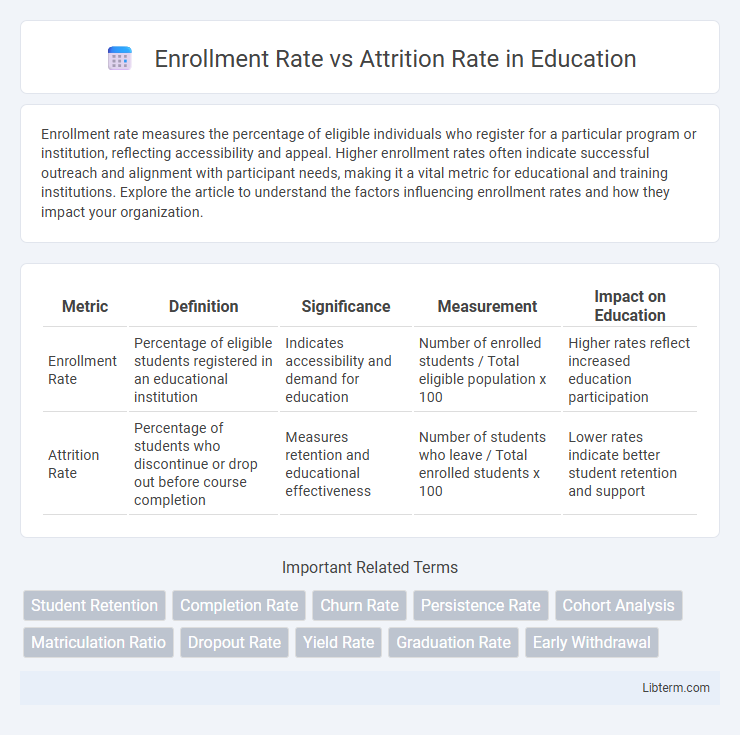Enrollment rate measures the percentage of eligible individuals who register for a particular program or institution, reflecting accessibility and appeal. Higher enrollment rates often indicate successful outreach and alignment with participant needs, making it a vital metric for educational and training institutions. Explore the article to understand the factors influencing enrollment rates and how they impact your organization.
Table of Comparison
| Metric | Definition | Significance | Measurement | Impact on Education |
|---|---|---|---|---|
| Enrollment Rate | Percentage of eligible students registered in an educational institution | Indicates accessibility and demand for education | Number of enrolled students / Total eligible population x 100 | Higher rates reflect increased education participation |
| Attrition Rate | Percentage of students who discontinue or drop out before course completion | Measures retention and educational effectiveness | Number of students who leave / Total enrolled students x 100 | Lower rates indicate better student retention and support |
Understanding Enrollment Rate: Definition and Importance
Enrollment rate measures the percentage of eligible students who register for a course or institution within a specific period, reflecting institution appeal and access. Understanding enrollment rate is crucial for identifying growth opportunities, resource allocation, and forecasting future demand for educational programs. A higher enrollment rate signals successful recruitment strategies and effective outreach to prospective students.
What is Attrition Rate? Key Concepts Explained
Attrition Rate, also known as dropout rate, measures the percentage of students who leave a program or institution before completion. It is a critical metric in education, indicating student retention and institutional effectiveness. High attrition rates often reflect challenges such as inadequate support, academic difficulties, or lack of engagement, making it essential for schools to monitor and address these factors to improve overall enrollment success.
Enrollment Rate vs Attrition Rate: Core Differences
Enrollment rate measures the percentage of new students registering in a program or institution within a specific period, reflecting the institution's ability to attract learners. Attrition rate indicates the proportion of students who discontinue or drop out before completing their course, highlighting retention challenges. Understanding the core differences between enrollment rate and attrition rate is essential for evaluating educational effectiveness and planning strategies for student success.
Factors Affecting Enrollment Rate in Institutions
Factors affecting enrollment rate in institutions include the quality of academic programs, availability of financial aid, and reputation of the school. Socioeconomic status of prospective students, accessibility of campus facilities, and effectiveness of marketing and outreach efforts also play significant roles. Institutional policies on admission criteria and student support services further influence the overall enrollment rate.
Common Causes of High Attrition Rates
High attrition rates in organizations often stem from lack of employee engagement, inadequate training programs, and poor communication channels. Enrollment rates may initially be strong, but retention falters when job roles are unclear or growth opportunities are limited. Addressing these issues through effective onboarding, continuous learning, and transparent feedback mechanisms can significantly reduce workforce turnover.
Measuring Enrollment and Attrition: Key Metrics
Enrollment rate quantifies the percentage of eligible individuals who register for a program, reflecting its initial appeal and accessibility. Attrition rate measures the proportion of participants who discontinue before completion, indicating challenges in engagement or satisfaction. Key metrics for assessing these rates include total eligible population, number of enrolled participants, dropouts, and program completion counts, which together enable precise evaluation of program retention and success.
Impact of Enrollment Rate on Institutional Growth
A higher enrollment rate significantly drives institutional growth by increasing tuition revenue, expanding program offerings, and enhancing campus resources. Sustained enrollment growth boosts the institution's reputation, attracting quality faculty and partnerships, which in turn supports academic excellence and innovation. Efficient management of enrollment strategies is crucial to balancing student intake with retention to maximize long-term stability and expansion.
Consequences of Attrition Rates for Organizations
High attrition rates significantly impact organizational stability, leading to increased recruitment and training costs that drain financial resources. Employee turnover disrupts workflow continuity and reduces overall productivity, hampering long-term business growth. Persistent attrition also weakens team morale and organizational culture, making it difficult to retain top talent and maintain competitive advantage.
Strategies to Improve Enrollment and Reduce Attrition
Implement targeted marketing campaigns and streamline the admission process to boost enrollment rates effectively. Enhance student support services, such as tutoring and counseling, to reduce attrition by addressing academic and personal challenges early. Leverage data analytics to identify at-risk students and customize interventions, promoting higher retention and sustained enrollment growth.
Future Trends: Balancing Enrollment and Attrition Rates
Future trends in higher education emphasize achieving equilibrium between enrollment rate growth and attrition rate reduction to ensure sustainable student population management. Advanced data analytics and predictive modeling help institutions identify at-risk students early, enabling targeted interventions that improve retention while maintaining healthy enrollment pipelines. Embracing technology-driven student support systems and personalized learning experiences will be critical in balancing enrollment and attrition rates effectively.
Enrollment Rate Infographic

 libterm.com
libterm.com